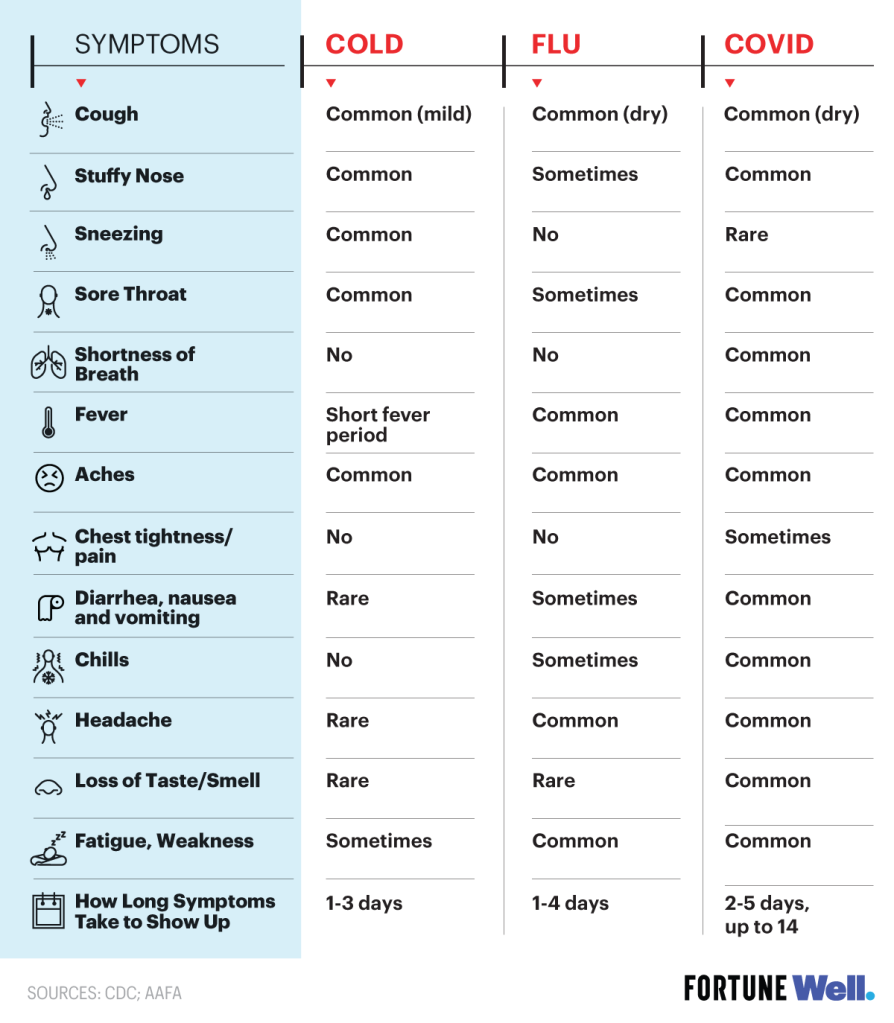COVID, flu, the common cold: What are the symptoms?
Flu season is underway, new COVID-19 sub variants are emerging, and the common cold, while always circulating, is more prevalent in the colder months, which means you may not know which virus is responsible for your symptoms.
Medical experts confirm that the overlapping symptoms can make it difficult to decipher which virus you have, which is why it’s important to get tested, says Dr. Benjamin Abramoff, assistant professor of clinical physical medicine and rehabilitation and the director of the Penn Medicine post COVID assessment and recovery clinic. Testing for COVID-19 and the flu can help you understand the best course of action, such as talking with your doctor about whether you should take drugs like Paxlovid or Tamiflu, which can reduce the duration of COVID and flu respectively, or whether you need to isolate from family and for how long.
What’s the difference between flu and covid?
Flu and COVID are both respiratory illnesses that arise from the spread of different viruses. The flu usually peaks between December and February, according to the U.S. Centers for Disease Control and Prevention (CDC), and the severity of the flu depends on the season and how the flu vaccine correlates to what circulates, says Dr. Preeti Malani, an infectious disease physician at the University of Michigan.
COVID-19 isn’t tied to a particular season although experts speculate that there will be another COVID wave between October and January.
Although having either the flu or COVID can present as asymptomatic, those with the flu typically feel symptoms right away, between one and four days after infection, while those with COVID can feel them from two to five days after or anywhere up to 14 days, per the CDC.
COVID is reported to spread more easily than the flu, especially when people are asymptomatic.
While flu and COVID seem similar at the onset, post COVID symptoms, like brain fog, fatigue, change in smell or taste among others, are unique to the virus and still being studied.
What are the symptoms of COVID, the flu and the common cold?
According to the CDC, the symptoms of any viral infection are similar, although it is more common to have a loss of smell and taste if you’re expiring a COVID-19 reaction versus the flu or a cold. Here are the symptoms, with information from the AAFA and the CDC.

Cold symptoms
How soon after exposure symptoms start: 1-3 days
Fever: Short fever period
Aches: Common
Chills: no
Fatigue, weakness: sometimes
Sneezing: Common
Cough: Common (mild)
Stuffy nose: Common
Sore throat: Common
Headache: Rare
Shortness of breath: No
Chest tightness/pain: No
Loss of taste/smell: Rare
Diarrhea, nausea and vomiting: Rare
COVID symptoms
How soon after exposure symptoms start: 2-5 days, but up to 14
Fever: Common
Aches: Common
Chills: Common
Fatigue, weakness: Common
Sneezing: Rare
Cough: Common (usually dry)
Stuffy nose: Common
Sore throat: Common
Headache: Common
Shortness of breath: Common
Chest tightness/pain: Sometimes
Loss of taste/smell: Common
Diarrhea, nausea and vomiting: Common
Flu Symptoms
How soon after exposure symptoms start: 1-4 days
Fever: Common
Aches: Common
Chills: Sometimes
Fatigue/weakness: Common
Sneezing: No
Cough: Common (usually dry)
Stuffy nose: Sometimes
Sore throat: Sometimes
Headache: Common
Shortness of breath: No
Chest tightness/pain: No
Loss of taste/smell: Rare
Diarrhea, nausea and vomiting: Sometimes
AAFA does note that colds and flus can lead to asthma which present with trouble breathing, chest pain or tightness and/or rapid breathing.
How bad will the flu and COVID be this winter?
While it’s unclear how COVID-19 and the flu will manifest in the coming months, experts have their concerns. This season may be “a particularly bad flu season, on top of another potential COVID surge,” Abramoff says.
And “Omicron spinoffs” like the newly circulating BQ.1 and BQ.1.1 may increase COVID cases, although experts say the bivalent COVID booster will still increase protection.
To stay on top of the sick season, it’s best to be proactive, get vaccinated, boosted and test if you have symptoms, Abramoff says.
The bottom line is not exposing people if you feel sick, says Malani, noting it’s important to stay home from work when you feel any symptoms associated with these viruses.
“It becomes socially acceptable and, in fact very, very encouraged for people to say, ‘I’m not feeling well’ and ‘I can’t come to work.’”
This story was originally featured on Fortune.com
More from Fortune:
